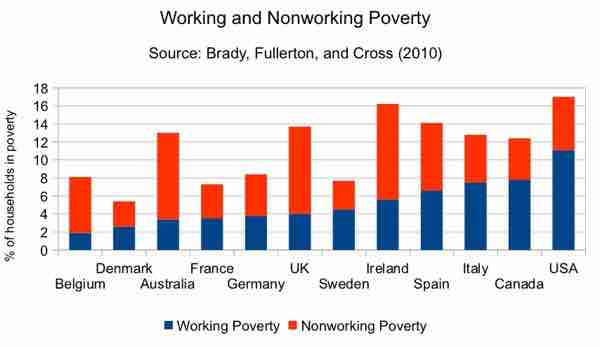The working poor are working people whose incomes fall below a given poverty line. While poverty is often associated with joblessness, the wages of the working poor are usually insufficient to provide basic necessities, causing them to face numerous obstacles that make it difficult for many of them to find and keep a job, save up money, and maintain a sense of self-worth. In 2009, according to the U.S. Census Bureau's official definition of poverty, 8.8 million US families were below the poverty line (11.1% of all families). Of these families, 5.19 million, or 58.9%, had at least one person who was classified as working

The Working Poor
Percentage of the working and nonworking poor in different countries
Within the United States, since the start of the War on Poverty in the 1960s, scholars and policymakers on both ends of the political spectrum have paid an increasing amount of attention to the working poor. One of the key ongoing debates concerns the distinction between the working and the nonworking (unemployed) poor. Conservative scholars and policymakers often attribute the prevalence of inequality and working poverty to overregulation and overtaxation, which they claim constricts job growth. In contrast, liberal scholars argue that the government should provide more housing assistance, childcare, and other kinds of aid to poor families, in order to help them overcome the obstacles they face.
Some of these obstacles may include finding affordable housing, arranging transportation to and from work, buying basic necessities, arranging childcare, having unpredictable work schedules, juggling two or more jobs, and coping with low-status work. Many scholars and policymakers suggest welfare state generosity, increased wages and benefits, more vocational education and training, increased child support, and increased rates of marriage as probable remedies to these obstacles.